WILDLIFE CRIME/TRADE/BREEDING
- Richprins
- Committee Member
- Posts: 76089
- Joined: Sat May 19, 2012 3:52 pm
- Location: NELSPRUIT
- Contact:
Re: WILDLIFE CRIME/TRADE/BREEDING
It really is a war! 

Please check Needs Attention pre-booking: https://africawild-forum.com/viewtopic.php?f=322&t=596
- Lisbeth
- Site Admin
- Posts: 67563
- Joined: Sat May 19, 2012 12:31 pm
- Country: Switzerland
- Location: Lugano
- Contact:
Re: WILDLIFE CRIME/TRADE/BREEDING
"Education is the most powerful weapon which you can use to change the world." Nelson Mandela
The desire for equality must never exceed the demands of knowledge
The desire for equality must never exceed the demands of knowledge
- Lisbeth
- Site Admin
- Posts: 67563
- Joined: Sat May 19, 2012 12:31 pm
- Country: Switzerland
- Location: Lugano
- Contact:
Re: WILDLIFE CRIME/TRADE/BREEDING
How money and technology are militarising the fight against the illegal wildlife trade
September 23, 2022 | Rosaleen Duffy
Professor of International Politics, University of Sheffield
Thousands of animals and plants are bought and sold each year globally as food, medicine, clothing and furniture – even in the form of musical instruments. Wildlife, it seems, is big business.
The illegal wildlife trade, which has an estimated value of at least US$7 billion (£5.9 billion) and potentially as much as US$23 billion, is driving some of the most well known species on Earth – especially rhinos, elephants, tigers, lions and, more recently, pangolins – towards extinction.
Since 2008, law enforcement has played a considerably bigger role in tackling the illegal wildlife trade, thanks to the support of governments, private donors, conservation charities and businesses. The result is that counter-insurgency techniques, such as developing informant networks and contracting private security firms to train rangers in anti-poaching operations with military-grade weapons, have proliferated.
Meanwhile, many conservationists are turning to drones and other technologies to monitor species and enforce protective measures. This in turn creates new business for tech companies keen to build a green reputation.
Countries must find a way to tackle the illegal wildlife trade. But, as a researcher of the international politics of conservation, I believe that techniques and technologies more regularly deployed by law enforcement and security firms are not the answer.
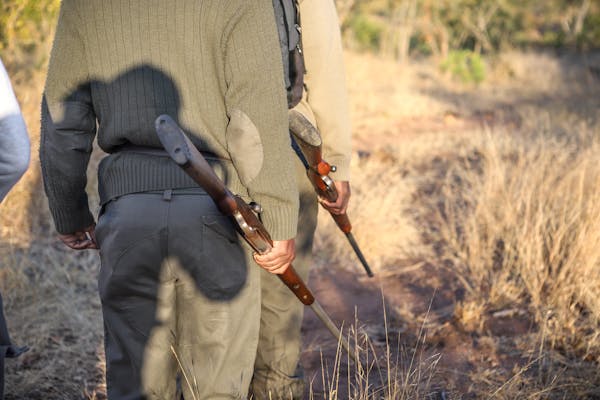
Rangers in Kruger Park, South Africa. WildSnap/Shutterstock
The funding problem
Between 2002 and 2018, the US Fish and Wildlife Service gave US$301 million to 4,142 conservation projects across 106 countries. Over the course of those 16 years, an increasing portion was allocated to tackling the illegal wildlife trade, as part of a shift from strict species protection and projects to improve livelihoods.
In 2014, the US Congress allocated US$45 million in its foreign assistance biodiversity budget to tackle wildlife trafficking, increasing to US$55 million in 2015, US$80 million in 2016 and almost US$91 million in 2017, 2018 and 2019. Similarly, the UK government’s illegal wildlife trade challenge fund allocated over £23 million to 75 projects between 2013 and 2019.
The fund had three themes: developing sustainable livelihoods that could replace poaching (six funded projects), strengthening law enforcement and the role of the criminal justice system (62 funded projects) and reducing demand for wildlife products (seven funded projects).
The role of philanthropists in conservation funding is growing. Examples include Howard Graham Buffet’s US$23 million donation in 2014 to help Kruger National park in South Africa tackle rhino poaching. Amazon founder Jeff Bezos established his US$10 billion Earth fund in 2021 to disburse grants to conservation initiatives, among other environmental causes.
This money can help conservationists respond quickly to emergency situations. Philanthropists tend to come from a business culture in which it’s normal to set goals and expect rapid, clear and trackable results in return for donations, which can be beneficial for planning effective action.
But some conservationists I interviewed while researching my book, Security and Conservation, said that it can result in unwelcome pressure on the people doing conservation work, such as rangers. They talked of expectations to increase the number of seizures of trafficked goods, obtain more arrests and generally pursue more aggressive anti-poaching efforts to secure quick results.
Technology and security
Conservation groups and tech companies have presented a range of technologies as cost-effective ways of cracking down on wildlife trafficking. These often involve forms of surveillance borrowed from the security sector, from drones and satellite monitoring of wildlife to artificial intelligence increasing the capacity of camera traps to identify potential poachers. Apps for the general public to report suspected illegal activity have even been developed.
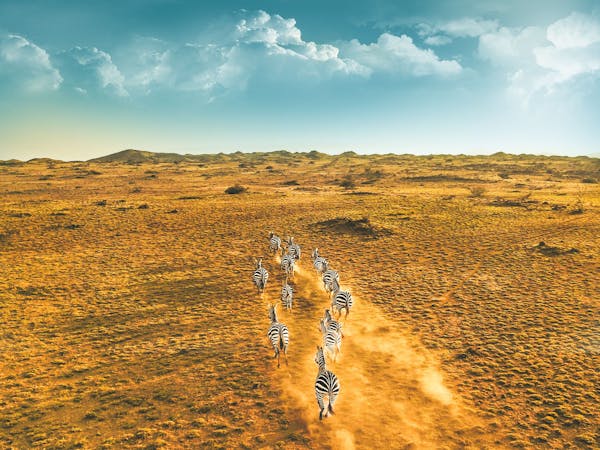
A herd of zebra running together on a dusty landscape.
Surveillance technology has increasingly used in conservation. Jost Jelovcan/Shutterstock
Google’s global impact awards had a fund of US$23 million to help “non-profit tech innovators” (as Google called them) develop technological solutions for a range of global challenges, including conservation. In 2012, it granted more than US$5 million to the wildlife crime technology project, which has pioneered aerial detection of poaching in Kenya and DNA sequencing to determine the origin of illegal wildlife products.
These techniques are not necessarily problematic. But the lure of technology can overshadow the vital work of addressing the underlying drivers of poaching and trafficking, such as poverty and inequality.
Though the trade is by definition illegal, addressing it as a purely criminal matter ignores the fact that people are drawn into poaching for a range of reasons. The colonial-era dispossession of people from places now designated as national parks has left an enduring legacy. A lack of economic alternatives in such places make poaching one of the few viable sources of income.
Global inequality is also a significant factor. Wildlife is often (but not exclusively) taken from poorer areas to serve demand in wealthier communities, with rosewood trafficked from Madagascar to China and illegal caviar sourced from the Caspian sea serving luxury markets in London and Paris, among others.
Financial support from governments and philanthropic foundations has been an important factor in conservation, especially in the last 20 years. But faith in finding technological solutions to a problem that’s treated as a security issue makes it harder to develop and support the alternatives that could be more effective, including sustainable livelihoods for would-be poachers and reducing demand in wealthier countries.
September 23, 2022 | Rosaleen Duffy
Professor of International Politics, University of Sheffield
Thousands of animals and plants are bought and sold each year globally as food, medicine, clothing and furniture – even in the form of musical instruments. Wildlife, it seems, is big business.
The illegal wildlife trade, which has an estimated value of at least US$7 billion (£5.9 billion) and potentially as much as US$23 billion, is driving some of the most well known species on Earth – especially rhinos, elephants, tigers, lions and, more recently, pangolins – towards extinction.
Since 2008, law enforcement has played a considerably bigger role in tackling the illegal wildlife trade, thanks to the support of governments, private donors, conservation charities and businesses. The result is that counter-insurgency techniques, such as developing informant networks and contracting private security firms to train rangers in anti-poaching operations with military-grade weapons, have proliferated.
Meanwhile, many conservationists are turning to drones and other technologies to monitor species and enforce protective measures. This in turn creates new business for tech companies keen to build a green reputation.
Countries must find a way to tackle the illegal wildlife trade. But, as a researcher of the international politics of conservation, I believe that techniques and technologies more regularly deployed by law enforcement and security firms are not the answer.

Rangers in Kruger Park, South Africa. WildSnap/Shutterstock
The funding problem
Between 2002 and 2018, the US Fish and Wildlife Service gave US$301 million to 4,142 conservation projects across 106 countries. Over the course of those 16 years, an increasing portion was allocated to tackling the illegal wildlife trade, as part of a shift from strict species protection and projects to improve livelihoods.
In 2014, the US Congress allocated US$45 million in its foreign assistance biodiversity budget to tackle wildlife trafficking, increasing to US$55 million in 2015, US$80 million in 2016 and almost US$91 million in 2017, 2018 and 2019. Similarly, the UK government’s illegal wildlife trade challenge fund allocated over £23 million to 75 projects between 2013 and 2019.
The fund had three themes: developing sustainable livelihoods that could replace poaching (six funded projects), strengthening law enforcement and the role of the criminal justice system (62 funded projects) and reducing demand for wildlife products (seven funded projects).
The role of philanthropists in conservation funding is growing. Examples include Howard Graham Buffet’s US$23 million donation in 2014 to help Kruger National park in South Africa tackle rhino poaching. Amazon founder Jeff Bezos established his US$10 billion Earth fund in 2021 to disburse grants to conservation initiatives, among other environmental causes.
This money can help conservationists respond quickly to emergency situations. Philanthropists tend to come from a business culture in which it’s normal to set goals and expect rapid, clear and trackable results in return for donations, which can be beneficial for planning effective action.
But some conservationists I interviewed while researching my book, Security and Conservation, said that it can result in unwelcome pressure on the people doing conservation work, such as rangers. They talked of expectations to increase the number of seizures of trafficked goods, obtain more arrests and generally pursue more aggressive anti-poaching efforts to secure quick results.
Technology and security
Conservation groups and tech companies have presented a range of technologies as cost-effective ways of cracking down on wildlife trafficking. These often involve forms of surveillance borrowed from the security sector, from drones and satellite monitoring of wildlife to artificial intelligence increasing the capacity of camera traps to identify potential poachers. Apps for the general public to report suspected illegal activity have even been developed.

A herd of zebra running together on a dusty landscape.
Surveillance technology has increasingly used in conservation. Jost Jelovcan/Shutterstock
Google’s global impact awards had a fund of US$23 million to help “non-profit tech innovators” (as Google called them) develop technological solutions for a range of global challenges, including conservation. In 2012, it granted more than US$5 million to the wildlife crime technology project, which has pioneered aerial detection of poaching in Kenya and DNA sequencing to determine the origin of illegal wildlife products.
These techniques are not necessarily problematic. But the lure of technology can overshadow the vital work of addressing the underlying drivers of poaching and trafficking, such as poverty and inequality.
Though the trade is by definition illegal, addressing it as a purely criminal matter ignores the fact that people are drawn into poaching for a range of reasons. The colonial-era dispossession of people from places now designated as national parks has left an enduring legacy. A lack of economic alternatives in such places make poaching one of the few viable sources of income.
Global inequality is also a significant factor. Wildlife is often (but not exclusively) taken from poorer areas to serve demand in wealthier communities, with rosewood trafficked from Madagascar to China and illegal caviar sourced from the Caspian sea serving luxury markets in London and Paris, among others.
Financial support from governments and philanthropic foundations has been an important factor in conservation, especially in the last 20 years. But faith in finding technological solutions to a problem that’s treated as a security issue makes it harder to develop and support the alternatives that could be more effective, including sustainable livelihoods for would-be poachers and reducing demand in wealthier countries.
"Education is the most powerful weapon which you can use to change the world." Nelson Mandela
The desire for equality must never exceed the demands of knowledge
The desire for equality must never exceed the demands of knowledge
- Lisbeth
- Site Admin
- Posts: 67563
- Joined: Sat May 19, 2012 12:31 pm
- Country: Switzerland
- Location: Lugano
- Contact:
Re: WILDLIFE CRIME/TRADE/BREEDING
Endangered wild animals traded by commercial Asian zoos
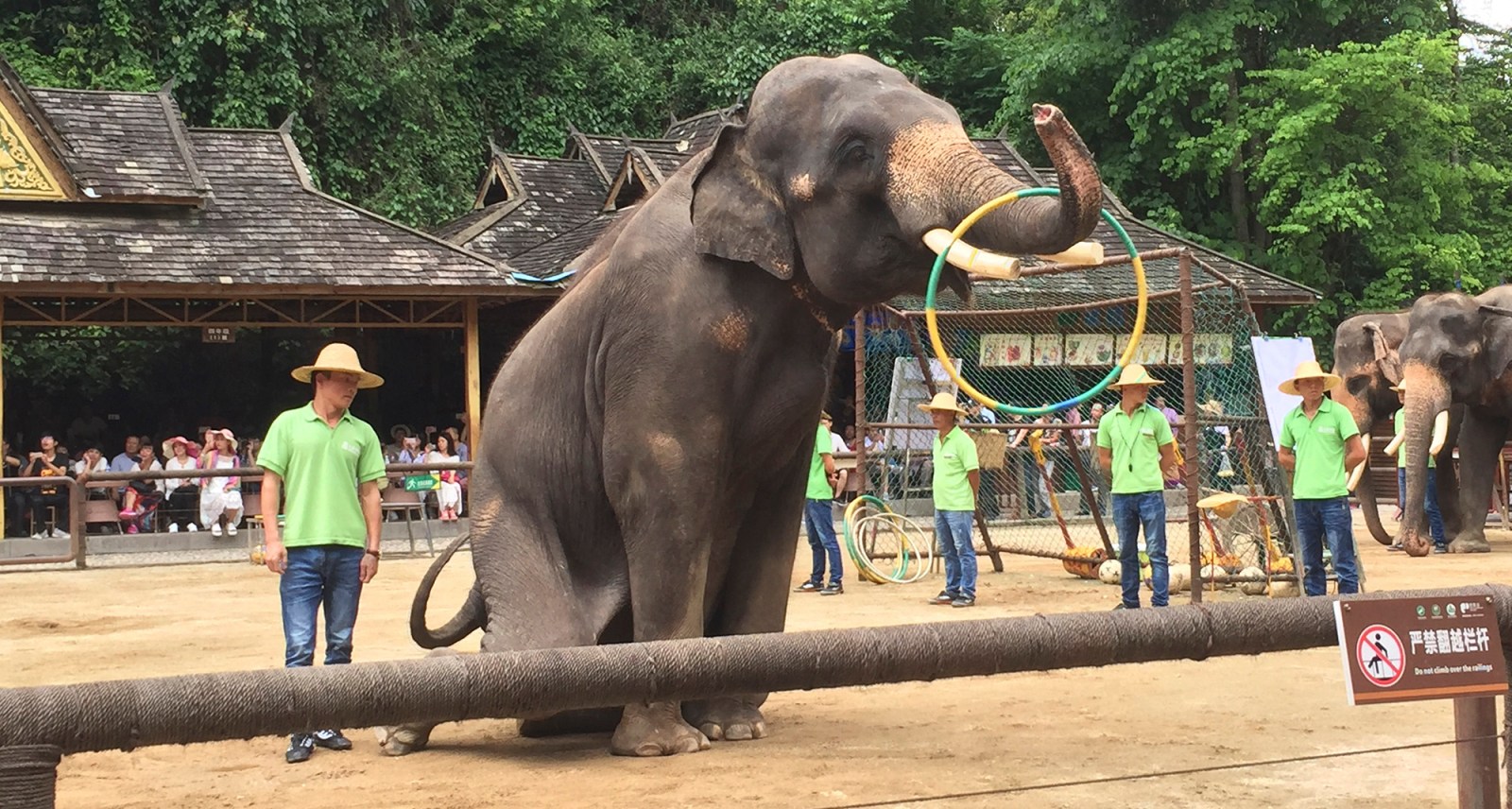
Elephants perform at Elephant Valley in Yunnan Province, China (Photo: Francis Garrard)
By Don Pinnock | 25 Sep 2022
The protection of critically endangered wild animals is being undermined as Asian zoos force them to perform for profit in violation of CITES regulations.
__________________________________________________________________________________________________________________
By the transposition of one letter for another in the permit code of the United Nations wildlife trade organisation CITES – Z for zoo instead of T for Commercial – critically endangered wild animals become tradeable for huge sums of money. It’s a loophole so big that the very intention of CITES is being systematically undermined.
The Oxford dictionary defines a zoo as a place where many kinds of wild animals are kept for public exhibition and where they are studied, bred and protected.
This is the spirit of the Convention on International Trade in Endangered Species of Wild Fauna and Flora (CITES) and upon which the agreement to permit sales of certain listed species of endangered wild animals to zoos was based.
It very specifically forbids transactions in Appendix 1-listed species “for primarily commercial purposes” – and for good reason. If zoos were permitted to buy and sell wild animals commercially, it would negate the entire purpose of the CITES Appendix 1 classification.
What the original drafters of that protocol could not have imagined was how certain zoos would morph into massive, money-driven tourist enterprises. Because of its cumbersome bureaucracy (change requires the consensus of 178 countries) CITES has been unable to plug a massive loophole that is ripping into the biodiversity of endangered wild creatures and warping the integrity of countries from which they come.
There’s a further problem. In CITES regulations there’s no definition of a zoo. Trade to zoos is happening under a loose and generous belief that all zoos must be for conservation and education.
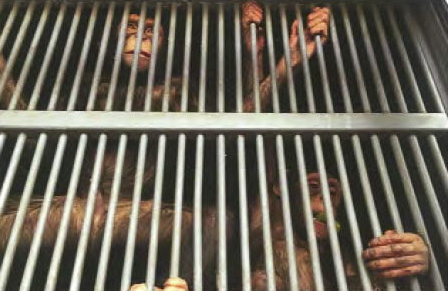
Chimps in a Chinese zoo. (Image: EMS Foundation)
In practice it doesn’t seem to matter if the zoo in question is unable to provide any conservation benefits or even meet minimal welfare requirements, nor does it matter if the trade to this so-called zoo has huge commercial value.
Read more in Daily Maverick: “CITES silent as Zimbabwe dooms elephants to living hell in China”
Countless examples unearthed by wildlife investigator Karl Ammann have shown that by simply proclaiming the transaction to be for zoo purposes, a commercial enterprise and transaction is able to escape from CITES’ most fundamental safeguard.
Protections
Appendix 1 is the highest CITES protection and covers wild-caught animals. It requires that their removal does not endanger the survival of the species, that their capture violated no national laws and that they may not be used for primarily commercial purposes.
Ammann has been ranging across China, Laos, Georgia and Pakistan documenting the types of zoos where wild-caught animals, mostly from Africa, are ending up and the conditions under which they’re kept.
What he found was shocking, with high levels of cruelty and almost zero public education. The sole reason for the animals there was to make money, in some cases eye-watering amounts. Almost all the CITES Appendix 1 safeguards are being ignored. All that seems to be needed is to put a Z (for zoo) on import and export permits.
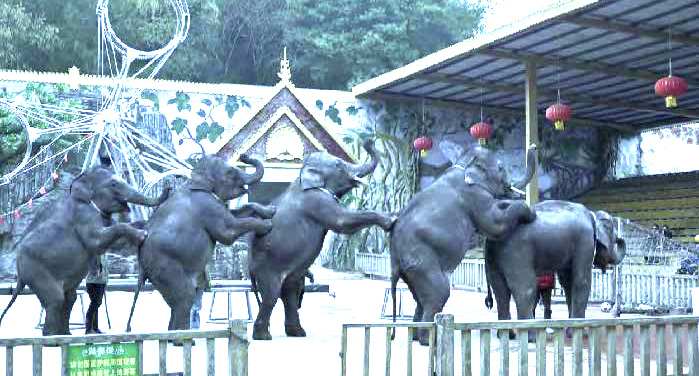
Elephants perform at Guizhou Forest Wildlife Zoo. (Image: EMS Foundation)
According to his report, published by the EMS Foundation, “time and time again commercial operations have been able to import critically endangered Appendix I species by claiming to be a zoo. These facilities are often commercial enterprises, often using animals for entertainment shows and exchanging significant sums of money in doing so.”
Zoo visits
Ammann discovered that the Xishuangbanna Wild Elephant Valley (Jinghong, China) imported 11 wild elephants from Laos and forced them to perform. The “zoo” attracts about 40,000 visitors on weekends, earning more than $2-million.
The Guizhou Forest Wildlife Zoo (Guiyang, China) imported 12 elephants in 2017. There are only nine left, according to the keepers. It is suspected that the other three elephants have been resold.
Keepers at the facility confirmed that they buy elephants from a wildlife dealer, a Mr Zhang, for about$350,000 for an adult (more for an infant). Video footage shows a performance arena with football nets and various other performing props for elephant shows.
In 2019, Longemont Safari Park (Huzhou, Zhejiang, China) imported eight wild elephants from Laos which were trained at Guizhou and are used for performances.
Ammann discovered that the facility, which was opened recently, expects about 30,000 visitors a day, with an expected average $40 entry fee per person, and is guaranteed to generate millions of dollars.
In 2019, Longemont imported 32 African elephants, of which 20 were kept and trained there while 12 were moved to another safari park. Ammann was told the purchase price for these elephants was $125,000 each.
In two months this year, according to its website, it attracted three million tourists, netting R1.7-billion.
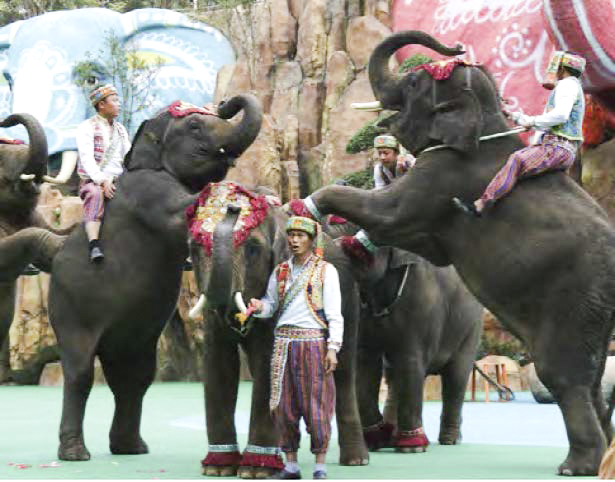
Elephants perform at Longemont Safari Park in China. (Image: Supplied)
Beijing Wildlife Park, which imported four elephants from Laos and 18 chimps from South Africa, is registered as a company with an annual turnover of about $7-million. According to Ammann “its activities are primarily commercial and involve poor treatment of Appendix I elephants in order to generate profit. In accordance with the protections under CITES, import permits should not have been granted.”
The chimps were imported under the Z code and source code C, which means captive bred. There is, however, no evidence that they were conceived in a captive facility in South Africa and were therefore Appendix 1. The chimps, says Ammann, are clearly a key attraction for Beijing Wildlife Park, with the objective of bringing more paying visitors through the door.
Green World Breeding Farm (China) belongs to a Chinese brokering company, Golden Land Animal Trade, which imports animals, sometimes on behalf of other businesses and sometimes to sell off to Chinese and other international zoos. Green World is itself not a zoo.
Golden Land was implicated in the smuggling of 138 chimpanzees from Guinea to China between 2007 and 2012. It is also named as one of the biggest of three animal wholesale companies in China that acts as an intermediary for traffickers and final buyers.
This company, says Ammann, boasts about importing most of the wild animals into China. It claims on its website to have imported a number of rare specimens, including elephants and chimps, for more than 100 zoos and aquariums in China in the past 10 years. “Not a single final destination of any of the animals imported from South Africa by Golden Land Animal Trade Co Ltd is known,” says Ammann.
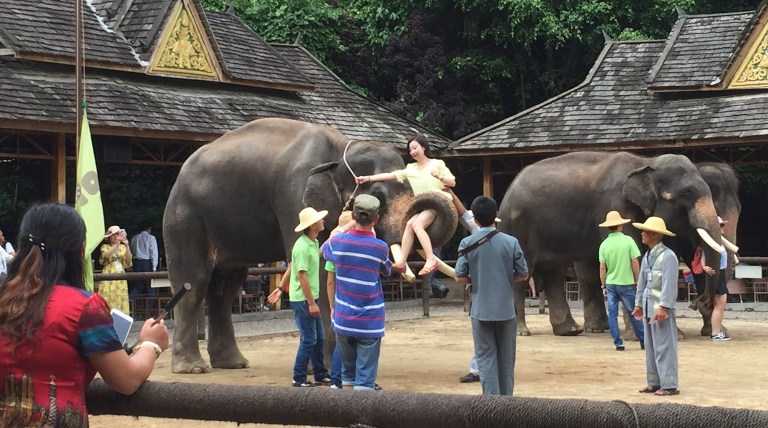
Performing elephants at Elephant Valley in Yunnan Province. (Photo: Francis Garrard)
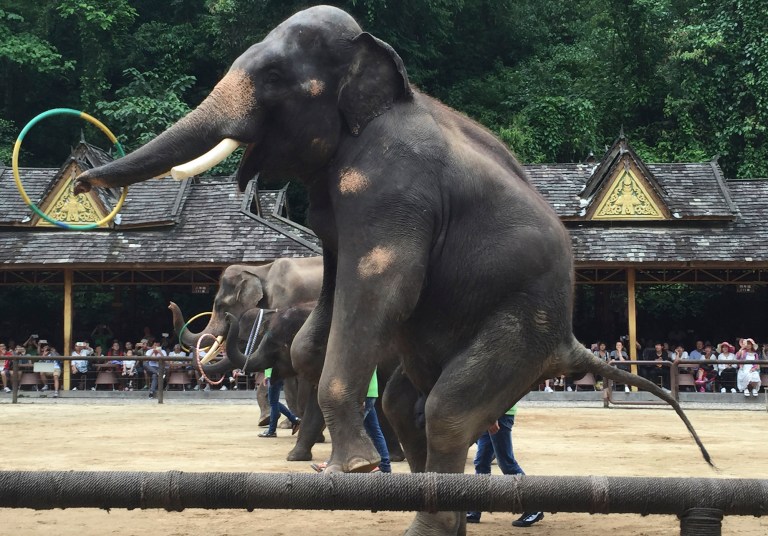
Elephants are forced to perform at Elephant Valley. (Photo: Francis Garrard)
In Pakistan, the secretary of forests and wildlife, Shahid Zaman, said that “surplus” animals at Lahore Zoo would be distributed across 21 wildlife parks and zoos in Punjab for breeding or auctioned to the public. The latter clearly has no conservation value.
At Zootopia in Georgia, Appendix 1 tamarins and lemurs were imported from Mystic Monkeys & Feathers in South Africa under the Z code but were being kept in a shopping mall with no natural light.
The EMS report proposed a draft resolution to the forthcoming CITES convention, calling on it to frame a clear definition of the term “zoo” and to clarify commercial and non-commercial activities.

A Longmont Safari Park show. (Image: Karl Ammann)
General principles, it says, should include a clear prohibition of Appendix 1 species being given a Z code if their purpose is primarily commercial. An activity should only be described as “zoological” if it wishes to effectively breed and conserve a species and educate the public on that species.
“Purpose code Z must not be used unless the specimen is kept in a suitable environment for its species and cared for using best practice husbandry.”
The head of CITES legal affairs and compliance, Sophie Hensborg, was approached for comment on this story but, by time of publication, no response had been received.

Elephants perform at Elephant Valley in Yunnan Province, China (Photo: Francis Garrard)
By Don Pinnock | 25 Sep 2022
The protection of critically endangered wild animals is being undermined as Asian zoos force them to perform for profit in violation of CITES regulations.
__________________________________________________________________________________________________________________
By the transposition of one letter for another in the permit code of the United Nations wildlife trade organisation CITES – Z for zoo instead of T for Commercial – critically endangered wild animals become tradeable for huge sums of money. It’s a loophole so big that the very intention of CITES is being systematically undermined.
The Oxford dictionary defines a zoo as a place where many kinds of wild animals are kept for public exhibition and where they are studied, bred and protected.
This is the spirit of the Convention on International Trade in Endangered Species of Wild Fauna and Flora (CITES) and upon which the agreement to permit sales of certain listed species of endangered wild animals to zoos was based.
It very specifically forbids transactions in Appendix 1-listed species “for primarily commercial purposes” – and for good reason. If zoos were permitted to buy and sell wild animals commercially, it would negate the entire purpose of the CITES Appendix 1 classification.
What the original drafters of that protocol could not have imagined was how certain zoos would morph into massive, money-driven tourist enterprises. Because of its cumbersome bureaucracy (change requires the consensus of 178 countries) CITES has been unable to plug a massive loophole that is ripping into the biodiversity of endangered wild creatures and warping the integrity of countries from which they come.
There’s a further problem. In CITES regulations there’s no definition of a zoo. Trade to zoos is happening under a loose and generous belief that all zoos must be for conservation and education.

Chimps in a Chinese zoo. (Image: EMS Foundation)
In practice it doesn’t seem to matter if the zoo in question is unable to provide any conservation benefits or even meet minimal welfare requirements, nor does it matter if the trade to this so-called zoo has huge commercial value.
Read more in Daily Maverick: “CITES silent as Zimbabwe dooms elephants to living hell in China”
Countless examples unearthed by wildlife investigator Karl Ammann have shown that by simply proclaiming the transaction to be for zoo purposes, a commercial enterprise and transaction is able to escape from CITES’ most fundamental safeguard.
Protections
Appendix 1 is the highest CITES protection and covers wild-caught animals. It requires that their removal does not endanger the survival of the species, that their capture violated no national laws and that they may not be used for primarily commercial purposes.
Ammann has been ranging across China, Laos, Georgia and Pakistan documenting the types of zoos where wild-caught animals, mostly from Africa, are ending up and the conditions under which they’re kept.
What he found was shocking, with high levels of cruelty and almost zero public education. The sole reason for the animals there was to make money, in some cases eye-watering amounts. Almost all the CITES Appendix 1 safeguards are being ignored. All that seems to be needed is to put a Z (for zoo) on import and export permits.

Elephants perform at Guizhou Forest Wildlife Zoo. (Image: EMS Foundation)
According to his report, published by the EMS Foundation, “time and time again commercial operations have been able to import critically endangered Appendix I species by claiming to be a zoo. These facilities are often commercial enterprises, often using animals for entertainment shows and exchanging significant sums of money in doing so.”
Zoo visits
Ammann discovered that the Xishuangbanna Wild Elephant Valley (Jinghong, China) imported 11 wild elephants from Laos and forced them to perform. The “zoo” attracts about 40,000 visitors on weekends, earning more than $2-million.
The Guizhou Forest Wildlife Zoo (Guiyang, China) imported 12 elephants in 2017. There are only nine left, according to the keepers. It is suspected that the other three elephants have been resold.
Keepers at the facility confirmed that they buy elephants from a wildlife dealer, a Mr Zhang, for about$350,000 for an adult (more for an infant). Video footage shows a performance arena with football nets and various other performing props for elephant shows.
- Not a single final destination of any of the animals imported from South Africa by Golden Land Animal Trade Co Ltd is known.
In 2019, Longemont Safari Park (Huzhou, Zhejiang, China) imported eight wild elephants from Laos which were trained at Guizhou and are used for performances.
Ammann discovered that the facility, which was opened recently, expects about 30,000 visitors a day, with an expected average $40 entry fee per person, and is guaranteed to generate millions of dollars.
In 2019, Longemont imported 32 African elephants, of which 20 were kept and trained there while 12 were moved to another safari park. Ammann was told the purchase price for these elephants was $125,000 each.
In two months this year, according to its website, it attracted three million tourists, netting R1.7-billion.

Elephants perform at Longemont Safari Park in China. (Image: Supplied)
Beijing Wildlife Park, which imported four elephants from Laos and 18 chimps from South Africa, is registered as a company with an annual turnover of about $7-million. According to Ammann “its activities are primarily commercial and involve poor treatment of Appendix I elephants in order to generate profit. In accordance with the protections under CITES, import permits should not have been granted.”
The chimps were imported under the Z code and source code C, which means captive bred. There is, however, no evidence that they were conceived in a captive facility in South Africa and were therefore Appendix 1. The chimps, says Ammann, are clearly a key attraction for Beijing Wildlife Park, with the objective of bringing more paying visitors through the door.
Green World Breeding Farm (China) belongs to a Chinese brokering company, Golden Land Animal Trade, which imports animals, sometimes on behalf of other businesses and sometimes to sell off to Chinese and other international zoos. Green World is itself not a zoo.
Golden Land was implicated in the smuggling of 138 chimpanzees from Guinea to China between 2007 and 2012. It is also named as one of the biggest of three animal wholesale companies in China that acts as an intermediary for traffickers and final buyers.
This company, says Ammann, boasts about importing most of the wild animals into China. It claims on its website to have imported a number of rare specimens, including elephants and chimps, for more than 100 zoos and aquariums in China in the past 10 years. “Not a single final destination of any of the animals imported from South Africa by Golden Land Animal Trade Co Ltd is known,” says Ammann.

Performing elephants at Elephant Valley in Yunnan Province. (Photo: Francis Garrard)

Elephants are forced to perform at Elephant Valley. (Photo: Francis Garrard)
In Pakistan, the secretary of forests and wildlife, Shahid Zaman, said that “surplus” animals at Lahore Zoo would be distributed across 21 wildlife parks and zoos in Punjab for breeding or auctioned to the public. The latter clearly has no conservation value.
At Zootopia in Georgia, Appendix 1 tamarins and lemurs were imported from Mystic Monkeys & Feathers in South Africa under the Z code but were being kept in a shopping mall with no natural light.
The EMS report proposed a draft resolution to the forthcoming CITES convention, calling on it to frame a clear definition of the term “zoo” and to clarify commercial and non-commercial activities.

A Longmont Safari Park show. (Image: Karl Ammann)
General principles, it says, should include a clear prohibition of Appendix 1 species being given a Z code if their purpose is primarily commercial. An activity should only be described as “zoological” if it wishes to effectively breed and conserve a species and educate the public on that species.
“Purpose code Z must not be used unless the specimen is kept in a suitable environment for its species and cared for using best practice husbandry.”
The head of CITES legal affairs and compliance, Sophie Hensborg, was approached for comment on this story but, by time of publication, no response had been received.
"Education is the most powerful weapon which you can use to change the world." Nelson Mandela
The desire for equality must never exceed the demands of knowledge
The desire for equality must never exceed the demands of knowledge
- Lisbeth
- Site Admin
- Posts: 67563
- Joined: Sat May 19, 2012 12:31 pm
- Country: Switzerland
- Location: Lugano
- Contact:
Re: WILDLIFE CRIME/TRADE/BREEDING
Should more wildlife trade be legal and regulated? It’s complicated, Rea]

READ MORE

- As the global international trade treaty approaches its half century anniversary, some scientists say it needs an overhaul to make its structures fit for 21st century.
- Allowing for legal, regulated trade could be better than banning it for many species, they argue, referring to successful case studies where local communities were involved in sustainable trade.
- But some conservationists are worried that changing the way CITES operates will be bad news for endangered wildlife and point out it has been a significant factor in the survival of species such as elephants and tigers.
READ MORE
"Education is the most powerful weapon which you can use to change the world." Nelson Mandela
The desire for equality must never exceed the demands of knowledge
The desire for equality must never exceed the demands of knowledge
- Lisbeth
- Site Admin
- Posts: 67563
- Joined: Sat May 19, 2012 12:31 pm
- Country: Switzerland
- Location: Lugano
- Contact:
Re: WILDLIFE CRIME/TRADE/BREEDING
OUR KIN DISCARDED: South Africa’s inhumane and indefensible trade and killing of (nonhuman) primates
BY EMS & BAT - INVESTIGATIVE REPORT - FEBRUARY 2023
South Africa is failing in their oversight of the legal export of non-human primates and their body parts , effectively condoning needless cruelty to these innocent animals.
In only 7 years between January 2016 and December 2022 through just a single port of exit – OR Tambo Airport – there were exports of 3,782 live primates and 5,401 hunting trophies consisting of 3,349 chacma baboons, 1,886 vervet monkeys and 9 bushbabies.
During this period 1,141 live indigenous bushbabies were exported.
Most of the live exports were for commercial trade (not zoos) into countries with highly dubious animal protection histories like Bangladesh, China, UAE and Armenia.
An extensive investigation report by the EMS Foundation and Ban Animal Trading has found South Africa’s primate trade to be poorly managed, ecologically damaging, unsustainable and raises welfare and ecological concerns.
Our Kin Discarded lists a string of systemic official failures:
The 40-page report was based on official information obtained by the EMS Foundation from the South African Department of Forestry, Fisheries and the Environment (DFFE), via the Promotion of Access to Information Act (PAIA), about the trade in CITES listed (nonhuman) primates. The Report includes extensive graphs as well as an analysis of the situation concerning each non-human primate.
10 steps South Africa needs to urgently take to arrest a deplorable situation:
All (nonhuman) primates are wild animals and they are fundamentally unsuited to captivity. Cognitively, behaviourally, emotionally and socially, they are some of the most complex animal species on earth. Their capture and removal from their natural habitats and social and family groups is extremely cruel and inflicts great suffering and distress, as well as resulting in injuries and even death.
The illegal trade in great apes, such as chimpanzees, is often supported by wholesalers in China, Bangladesh the UAE and Armenia, who “often act as intermediaries between the traffickers and the final buyers in Asia, the Middle East and Russia. China has at least four known such wholesalers. The primate pet trade, bolstered by social media, continues to grow and impacts the survival of individuals and wild populations globally.
Bangladesh does not allow import of primates yet the Report found evidence of extensive imports to false or non-existent addresses in Bangladesh
A report by the South African Anti-Money Laundering Integrated Task Force (SAMLIT) published in November 2021, corroborates the research by BAT and EMS and noted that the use of the legal wildlife industry masks illegal trade and is prevalent in South Africa. This occurs when legal exports are either under-declared or prohibited species are exported alongside legal exports.
South Africa is home to six indigenous primate species. All these species are susceptible to escalating habitat loss as well as removal from the wild and indiscriminate hunting.

Daily Mirror, 1 Septermber 2019 – www.mirror.co.uk/news/uk-news/sick-brit ... s-19120277
For interviews or further information please contact: Michelle@emsfoundation.org.za
READ THE FULL REPORT:
https://emsfoundation.org.za/our-kin-di ... -primates/
BY EMS & BAT - INVESTIGATIVE REPORT - FEBRUARY 2023
South Africa is failing in their oversight of the legal export of non-human primates and their body parts , effectively condoning needless cruelty to these innocent animals.
In only 7 years between January 2016 and December 2022 through just a single port of exit – OR Tambo Airport – there were exports of 3,782 live primates and 5,401 hunting trophies consisting of 3,349 chacma baboons, 1,886 vervet monkeys and 9 bushbabies.
During this period 1,141 live indigenous bushbabies were exported.
Most of the live exports were for commercial trade (not zoos) into countries with highly dubious animal protection histories like Bangladesh, China, UAE and Armenia.
An extensive investigation report by the EMS Foundation and Ban Animal Trading has found South Africa’s primate trade to be poorly managed, ecologically damaging, unsustainable and raises welfare and ecological concerns.
Our Kin Discarded lists a string of systemic official failures:
- Official data capture includes documentation discrepancies
- Illegal shipments
- Untraceable destinations
- Enforcement negligence
- Lack of oversight and verification
- Inadequate safeguards
- Irrational or arbitrary hunting determinations
- No national population assessments or Non-Detrimental Findings for indigenous primates, a clear contravention of CITES
The 40-page report was based on official information obtained by the EMS Foundation from the South African Department of Forestry, Fisheries and the Environment (DFFE), via the Promotion of Access to Information Act (PAIA), about the trade in CITES listed (nonhuman) primates. The Report includes extensive graphs as well as an analysis of the situation concerning each non-human primate.
10 steps South Africa needs to urgently take to arrest a deplorable situation:
- Implementation of an effective permitting system to ensure that information is valid, accurate and complete
- Oversight of the permitting system
- Ensure the availability of actual trade data for both effective decision-making and for compliance with CITES
- Review by authorities of how they manage indigenous primates to ensure that biodiversity is protected
- Comprehensively and transparently assess the impact of the legal trade via a Non-Detrimental Finding
- Ensure that the trade in non-indigenous primates does not threaten conservation in their country of origin
- Support in situ conservation and a compassionate approach in relation to nonhuman primates.
- Adopt a new ethos based on Ubuntu which sees people living in harmony with nature and not simply regarding it as an expendable resource or damage-causing
- Acknowledge that commercial trade in any primates ignores the complex social structures and cognitive abilities of primates and is ethically wrong
- Immediately issue a moratorium on the trade, hunting and killing of indigenous primates and the breeding, trading and keeping of exotic primates as pets.
All (nonhuman) primates are wild animals and they are fundamentally unsuited to captivity. Cognitively, behaviourally, emotionally and socially, they are some of the most complex animal species on earth. Their capture and removal from their natural habitats and social and family groups is extremely cruel and inflicts great suffering and distress, as well as resulting in injuries and even death.
The illegal trade in great apes, such as chimpanzees, is often supported by wholesalers in China, Bangladesh the UAE and Armenia, who “often act as intermediaries between the traffickers and the final buyers in Asia, the Middle East and Russia. China has at least four known such wholesalers. The primate pet trade, bolstered by social media, continues to grow and impacts the survival of individuals and wild populations globally.
Bangladesh does not allow import of primates yet the Report found evidence of extensive imports to false or non-existent addresses in Bangladesh
A report by the South African Anti-Money Laundering Integrated Task Force (SAMLIT) published in November 2021, corroborates the research by BAT and EMS and noted that the use of the legal wildlife industry masks illegal trade and is prevalent in South Africa. This occurs when legal exports are either under-declared or prohibited species are exported alongside legal exports.
South Africa is home to six indigenous primate species. All these species are susceptible to escalating habitat loss as well as removal from the wild and indiscriminate hunting.

Daily Mirror, 1 Septermber 2019 – www.mirror.co.uk/news/uk-news/sick-brit ... s-19120277
For interviews or further information please contact: Michelle@emsfoundation.org.za
READ THE FULL REPORT:
https://emsfoundation.org.za/our-kin-di ... -primates/
"Education is the most powerful weapon which you can use to change the world." Nelson Mandela
The desire for equality must never exceed the demands of knowledge
The desire for equality must never exceed the demands of knowledge
- Lisbeth
- Site Admin
- Posts: 67563
- Joined: Sat May 19, 2012 12:31 pm
- Country: Switzerland
- Location: Lugano
- Contact:
Re: WILDLIFE CRIME/TRADE/BREEDING
Who can own big cats in South Africa
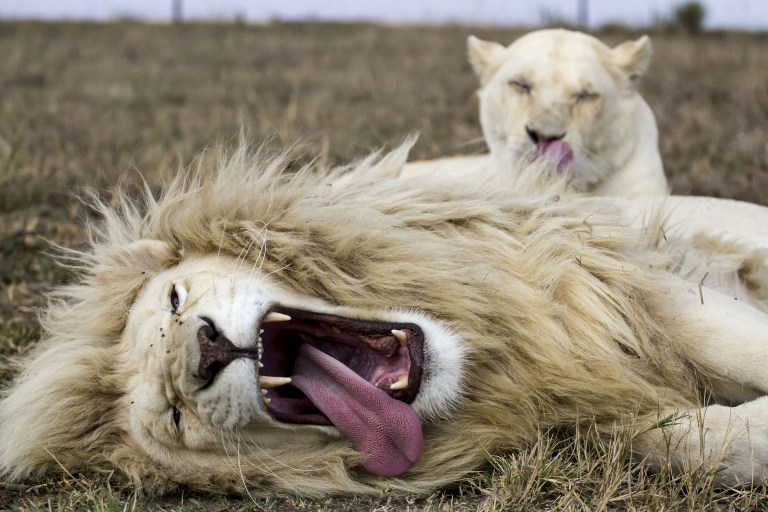
A white lion and his partner in an enclosure at the Weltevrede Lion Farm on May 23, 2013 in Heilbron, South Africa. Image: Gallo Images / The Times / Daniel Born
By Tevya Turok Shapiro | 15 Mar 2023
It is legal and seems terrifyingly simple to keep a tiger as a pet in some South African provinces. Here is a short summary of the rules and how they allegedly facilitate illegal trade.
____________________________________________________________________________________________________________________
On 6 May 1997, the British current affairs program Cook Report broadcast a video called Making a Killing that pried open the lid of the canned lion hunting industry in South Africa, using a sting operation.
The public outcry caused by this exposé led to a prohibition on the hunting of several predators, including lions, within 24 months of their release, but the South African Predator Breeders’ Association (SAPBA) challenged the prohibition, and in 2010 the Supreme Court of Appeal ruled in SAPBA’s favour on the basis of a lack of evidence that 24 months was required for a captive-bred lion to become self-sufficient in the wild.
Another big push in the campaign to protect lions came in 2015 from a documentary called Blood Lions which used similar undercover techniques to show unambiguously how brutally exploitative the captive breeding industry is. Following the film, the import of trophy corpses of captive lions was banned by Australia, France and then the US, and the value of captive lions rapidly dropped.
Over the past few years, South Africa has committed to ending the canned hunting and captive breeding of lions. Some commercial breeders have defied the government’s directive and the ban on breeding is still not a solution to the even more insidious problem of bone trade.
Despite the legal progress being made to protect South Africa’s indigenous big cats, the same is not true for those from other parts of the world such as tigers. The legal distinction between indigenous animals and “exotic” animals means that even though many of the reasons to prohibit breeding are the same, the fight has to be won a second time.
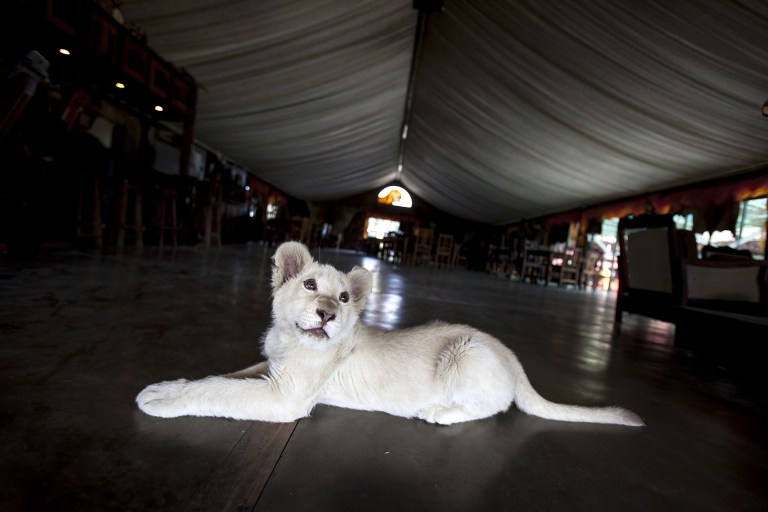
A lion cub lies on the floor of a bar at the Weltevrede Lion Farm on May 23, 2013 in Heilbron, South Africa. Image: Gallo Images / The Times / Daniel Born)
The distinction between indigenous and exotic animals
The National Environmental Management: Biodiversity Act 10 (NEMBA) classifies non-indigenous animals – “species imported into the Republic as a result of human activity” as “exotic”.
Bool Smuts is the director of the Landmark Foundation, a conservation NGO that gives input on government legislation and also litigates against administrators and individuals that contravene the few protections that wildlife species do have; he explains that indigenous species have a special designation within the law. They are referred to as Threatened Or Protected (TOP) species and thereby given several layers of protection under national law. But regulations for exotic animals are determined by provincial ordinances and they are not given that special protection – they can essentially be owned as property, and because of the history of South African law, that drastically changes the way they can be handled.
“Once you own something, you can kill it. That’s the nature of the South African legislation. South African law was inherited from Roman times; that’s why it’s called Roman-Dutch. Wealthy Romans wanted to protect their property from the proletariat, and that’s what led to the development of what is now ‘common law’ – the law that’s built up by precedent. And of course, who can go to court? The wealthy. So generally speaking, it’s the wealthy that sets the precedent.
“So that’s why to this day, your dog is an item of property. There are lots of people agitating for Rights of Nature – better laws for animals or non-human living things like rivers, because now in South Africa, animals and natural features have no rights. The Romans had no way of dealing with wild animals so it was decided that they were res nullius – they don’t belong to anybody, and only the state had the right to issue their ownership, through a permit system,” says Smuts.
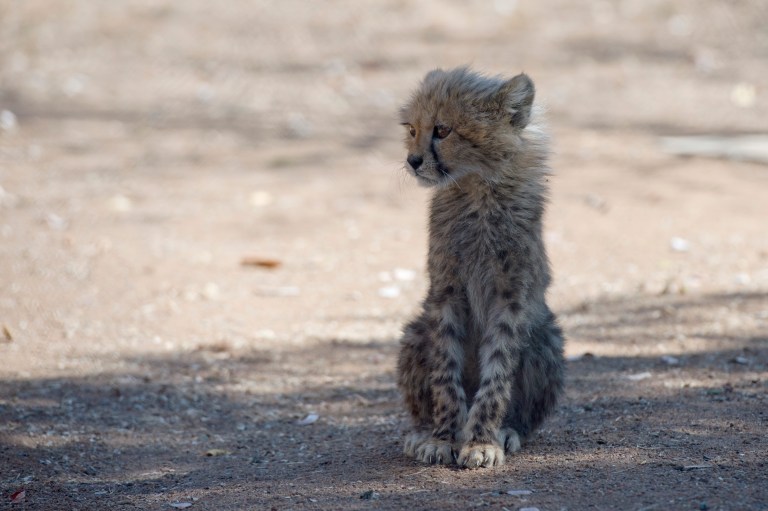
A cheetah seen at Willie Jacobs’s farm, Ukutula Lodge on July 31, 2015 in Brits, South Africa. At the time, Jacobs’s farm was heavily criticised after the release of the documentary ‘Blood Lions’, which details the distasteful practices of canned lion breeders and hunters. Image: Gallo Images / Rapport / Herman Verwey
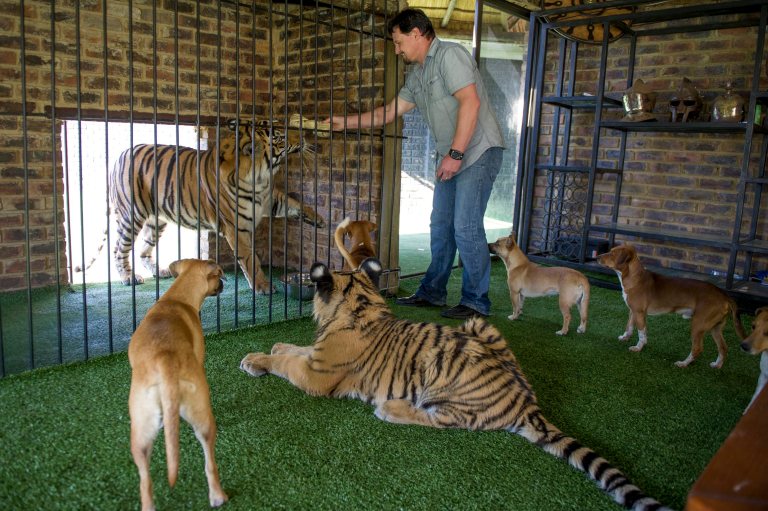
Michael Jamison with his two tigers and some of his hounds on May 31, 2013, in Brakpan, South Africa. Jamison adopted Ozzy, in addition to his 15 dogs and two-year-old Bengal tiger. Ozzy has deformed legs and feet as a result of malnutrition from his previous owners. Image: Gallo Images / Foto24 / Christian Kotze
What are the rules and restrictions pertaining to exotic big cats in South Africa?
Regulations pertaining to exotic big cats differ by province. Douglas Wolhuter, national chief inspector manager of the wildlife protection unit at NSPCA, explains:
“Some provinces require permits. In the Western Cape, for example, getting hold of a tiger to keep as a pet would be damn near impossible – you’d have to have a permit to bring the animal into the province and there are strict rules and policies and regulations which organisations such as Panthera have to adhere to in terms of keeping these animals.”
However, Wolhuter adds that no permit is required to own exotic animals in Gauteng, North West, Mpumalanga and Limpopo, so effectively, one could keep a non-indigenous apex predator in an agricultural zone without any paperwork.
Northern Cape, Eastern Cape, Western Cape, KwaZulu-Natal and Free State all require permits for the import, export and transport of exotic animals, as well as for possession and keeping permits. In the Western Cape, one would also require a Wild Animal Captivity Permit to be issued by CapeNature. All nine provinces also require that an owner provide the safe enclosure of exotic animals.
But Smuts feels these legislations are not properly enforced and, he says, many of the regulations are not formalised, so there are scarce guidelines, for example, as to what constitutes safe enclosure.
“If you want to buy an exotic tiger, for instance, you’d buy it from a person that is lawfully the owner of that animal, and that’s usually one of the breeding farms. Whether you’d require permits, and which kinds, would then be stipulated by virtue of your provincial ordinance, not the biodiversity act. So the province would then say, you can hold the animal provided you have safe enclosure for it … that safe enclosure may be your lounge; it could be anything as arbitrary as that. It’s more a public safety issue than biodiversity. Exotic big cats are regulated because they are dangerous animals.
“Of course you would also be subject to the Animal Protection Act, which states that the animal must be well cared for, but those legislations are extremely poorly implemented, and that’s why you get all these tigers walking around. The ethics surrounding people that hold these animals in various facilities are highly questionable.”
An important gauge of strictness for any regulation is the severity of the repercussions for contravening it. The Animal Protection Act (APA), which was last amended in 1998, deals with animal cruelty generally, and caps the penalty for animal-related offences stipulated in the document at R4,000 or imprisonment of up to 12 months. (page 14) Over and above that, penalties regarding exotic animals will depend on the province in which the crime was committed.
However, in terms of indigenous animals, (such as lions) as of its amendment of 2022, the National Environmental Management Laws Amendment Act 2 of 2022 (NEMBA, page 18) states that those found guilty of restricted activities such as breeding, hunting, export and so on will incur an administrative fine of up to R10-million, be imprisoned, or both.
Why environmentalists argue for tighter regulations
Smuts thinks that there are two primary reasons why people want better regulations:
“Firstly, we don’t believe there’s any conservation merits in retaining these species in captivity. There’s no benefit to conservation to have a tiger in captivity in South Africa. Zero. Secondly, many people disagree ethically with allowing animals to live unnatural, cruel lives in captivity.”
From both a legal and ethical perspective, Wolhuter, who speaks on behalf of the NSPCA, adds: “We believe there has to be much stronger regulation for the animals themselves from an animal welfare perspective, in terms of the conditions they are being kept from the angle of the Animals Protection Act.”
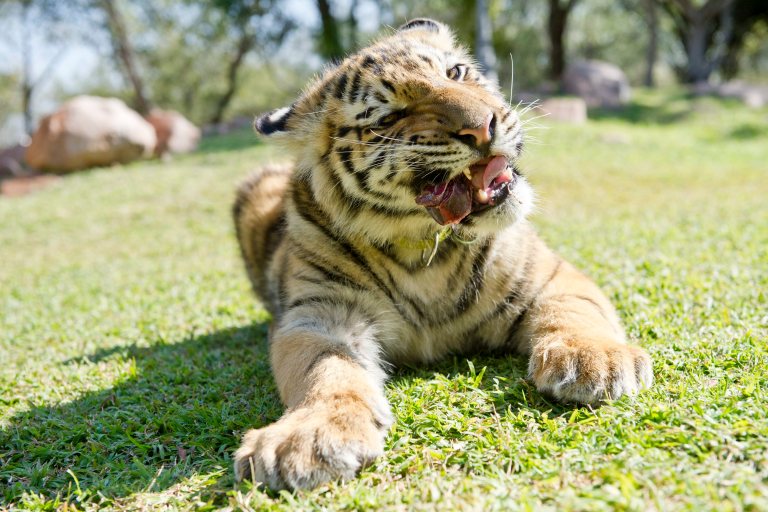
Panjo at Jugomaro Predator Park on May 21, 2013, in Groblersdal, South Africa. Owner, Goosey Fernandes, is an active advocate for the conservation of these predators. Fernandes first made headlines when Panjo fell off the back of his bakkie and was lost in the area for two days. Image: Gallo Images / Foto24 / Craig Nieuwenhuizen
Additionally, there’s the risk that improperly kept big cats pose to people; after all, they are powerful carnivorous animals that survive by killing other animals for their meat.
Just this year, a few tigers have gone on escapades through Johannesburg. One was put down after attacking a man and killing several animals; another was spotted across the road from Toddlers Corner children’s nursery. A lion was spotted in Gauteng close to the border with North West and is still on the loose at the time of publication. These escapes also bring human rights into the discussion in that such powerful predators can pose a safety risk to nearby communities.
Smuts’s opinion is that the government has resisted stronger enforcement because of how much money is involved in the industry
“The very big problem here is that we as a society want to commoditise absolutely everything, and at the buyers’ end, people don’t necessarily distinguish whether the rhino horn or tiger claw is from a poached or farmed animal. It’s almost impossible to know whether the commodity is coming from the so-called legal trade as opposed to the illegal trade. So the very existence of trade provides the opportunity for illegal trade to enter. It exists because of the massive flow of money.”
“The South African State has sold their souls to what they call ‘sustainable utilisation’, which we [The Landmark Foundation] believe should rather be called the sustained abuse of wildlife. What value does a black mamba have to the state, for example? Any animal that hasn’t been commoditised is devalued in the system. That’s the anathema of what biodiversity is. There’s a big lobby and you know, the president himself is a bloody game trader! So it’s completely driven by money.”
In 2020, the wildly popular Netflix docuseries, Tiger King, gave the big cat trade more global exposure than ever before, and has recently resulted in the US Senate passing the Big Cat Public Safety Act which prohibits owning big cats as well as any public contact with them. The question for South Africa is why we have not yet followed suit.
The rise in elephant poaching off the back of the legal ivory “fire sale” in 2008 is well documented. Similar correlations lead to the criminalisation of rhinoceros and lion breeding, and conservationists argue that it is no less the case for tigers and other exotic big cats. DM/ ML OBP

A white lion and his partner in an enclosure at the Weltevrede Lion Farm on May 23, 2013 in Heilbron, South Africa. Image: Gallo Images / The Times / Daniel Born
By Tevya Turok Shapiro | 15 Mar 2023
It is legal and seems terrifyingly simple to keep a tiger as a pet in some South African provinces. Here is a short summary of the rules and how they allegedly facilitate illegal trade.
____________________________________________________________________________________________________________________
On 6 May 1997, the British current affairs program Cook Report broadcast a video called Making a Killing that pried open the lid of the canned lion hunting industry in South Africa, using a sting operation.
The public outcry caused by this exposé led to a prohibition on the hunting of several predators, including lions, within 24 months of their release, but the South African Predator Breeders’ Association (SAPBA) challenged the prohibition, and in 2010 the Supreme Court of Appeal ruled in SAPBA’s favour on the basis of a lack of evidence that 24 months was required for a captive-bred lion to become self-sufficient in the wild.
Another big push in the campaign to protect lions came in 2015 from a documentary called Blood Lions which used similar undercover techniques to show unambiguously how brutally exploitative the captive breeding industry is. Following the film, the import of trophy corpses of captive lions was banned by Australia, France and then the US, and the value of captive lions rapidly dropped.
Over the past few years, South Africa has committed to ending the canned hunting and captive breeding of lions. Some commercial breeders have defied the government’s directive and the ban on breeding is still not a solution to the even more insidious problem of bone trade.
Despite the legal progress being made to protect South Africa’s indigenous big cats, the same is not true for those from other parts of the world such as tigers. The legal distinction between indigenous animals and “exotic” animals means that even though many of the reasons to prohibit breeding are the same, the fight has to be won a second time.

A lion cub lies on the floor of a bar at the Weltevrede Lion Farm on May 23, 2013 in Heilbron, South Africa. Image: Gallo Images / The Times / Daniel Born)
The distinction between indigenous and exotic animals
The National Environmental Management: Biodiversity Act 10 (NEMBA) classifies non-indigenous animals – “species imported into the Republic as a result of human activity” as “exotic”.
Bool Smuts is the director of the Landmark Foundation, a conservation NGO that gives input on government legislation and also litigates against administrators and individuals that contravene the few protections that wildlife species do have; he explains that indigenous species have a special designation within the law. They are referred to as Threatened Or Protected (TOP) species and thereby given several layers of protection under national law. But regulations for exotic animals are determined by provincial ordinances and they are not given that special protection – they can essentially be owned as property, and because of the history of South African law, that drastically changes the way they can be handled.
“Once you own something, you can kill it. That’s the nature of the South African legislation. South African law was inherited from Roman times; that’s why it’s called Roman-Dutch. Wealthy Romans wanted to protect their property from the proletariat, and that’s what led to the development of what is now ‘common law’ – the law that’s built up by precedent. And of course, who can go to court? The wealthy. So generally speaking, it’s the wealthy that sets the precedent.
“So that’s why to this day, your dog is an item of property. There are lots of people agitating for Rights of Nature – better laws for animals or non-human living things like rivers, because now in South Africa, animals and natural features have no rights. The Romans had no way of dealing with wild animals so it was decided that they were res nullius – they don’t belong to anybody, and only the state had the right to issue their ownership, through a permit system,” says Smuts.

A cheetah seen at Willie Jacobs’s farm, Ukutula Lodge on July 31, 2015 in Brits, South Africa. At the time, Jacobs’s farm was heavily criticised after the release of the documentary ‘Blood Lions’, which details the distasteful practices of canned lion breeders and hunters. Image: Gallo Images / Rapport / Herman Verwey

Michael Jamison with his two tigers and some of his hounds on May 31, 2013, in Brakpan, South Africa. Jamison adopted Ozzy, in addition to his 15 dogs and two-year-old Bengal tiger. Ozzy has deformed legs and feet as a result of malnutrition from his previous owners. Image: Gallo Images / Foto24 / Christian Kotze
What are the rules and restrictions pertaining to exotic big cats in South Africa?
Regulations pertaining to exotic big cats differ by province. Douglas Wolhuter, national chief inspector manager of the wildlife protection unit at NSPCA, explains:
“Some provinces require permits. In the Western Cape, for example, getting hold of a tiger to keep as a pet would be damn near impossible – you’d have to have a permit to bring the animal into the province and there are strict rules and policies and regulations which organisations such as Panthera have to adhere to in terms of keeping these animals.”
However, Wolhuter adds that no permit is required to own exotic animals in Gauteng, North West, Mpumalanga and Limpopo, so effectively, one could keep a non-indigenous apex predator in an agricultural zone without any paperwork.
Northern Cape, Eastern Cape, Western Cape, KwaZulu-Natal and Free State all require permits for the import, export and transport of exotic animals, as well as for possession and keeping permits. In the Western Cape, one would also require a Wild Animal Captivity Permit to be issued by CapeNature. All nine provinces also require that an owner provide the safe enclosure of exotic animals.
But Smuts feels these legislations are not properly enforced and, he says, many of the regulations are not formalised, so there are scarce guidelines, for example, as to what constitutes safe enclosure.
“If you want to buy an exotic tiger, for instance, you’d buy it from a person that is lawfully the owner of that animal, and that’s usually one of the breeding farms. Whether you’d require permits, and which kinds, would then be stipulated by virtue of your provincial ordinance, not the biodiversity act. So the province would then say, you can hold the animal provided you have safe enclosure for it … that safe enclosure may be your lounge; it could be anything as arbitrary as that. It’s more a public safety issue than biodiversity. Exotic big cats are regulated because they are dangerous animals.
“Of course you would also be subject to the Animal Protection Act, which states that the animal must be well cared for, but those legislations are extremely poorly implemented, and that’s why you get all these tigers walking around. The ethics surrounding people that hold these animals in various facilities are highly questionable.”
An important gauge of strictness for any regulation is the severity of the repercussions for contravening it. The Animal Protection Act (APA), which was last amended in 1998, deals with animal cruelty generally, and caps the penalty for animal-related offences stipulated in the document at R4,000 or imprisonment of up to 12 months. (page 14) Over and above that, penalties regarding exotic animals will depend on the province in which the crime was committed.
However, in terms of indigenous animals, (such as lions) as of its amendment of 2022, the National Environmental Management Laws Amendment Act 2 of 2022 (NEMBA, page 18) states that those found guilty of restricted activities such as breeding, hunting, export and so on will incur an administrative fine of up to R10-million, be imprisoned, or both.
Why environmentalists argue for tighter regulations
Smuts thinks that there are two primary reasons why people want better regulations:
“Firstly, we don’t believe there’s any conservation merits in retaining these species in captivity. There’s no benefit to conservation to have a tiger in captivity in South Africa. Zero. Secondly, many people disagree ethically with allowing animals to live unnatural, cruel lives in captivity.”
From both a legal and ethical perspective, Wolhuter, who speaks on behalf of the NSPCA, adds: “We believe there has to be much stronger regulation for the animals themselves from an animal welfare perspective, in terms of the conditions they are being kept from the angle of the Animals Protection Act.”

Panjo at Jugomaro Predator Park on May 21, 2013, in Groblersdal, South Africa. Owner, Goosey Fernandes, is an active advocate for the conservation of these predators. Fernandes first made headlines when Panjo fell off the back of his bakkie and was lost in the area for two days. Image: Gallo Images / Foto24 / Craig Nieuwenhuizen
Additionally, there’s the risk that improperly kept big cats pose to people; after all, they are powerful carnivorous animals that survive by killing other animals for their meat.
Just this year, a few tigers have gone on escapades through Johannesburg. One was put down after attacking a man and killing several animals; another was spotted across the road from Toddlers Corner children’s nursery. A lion was spotted in Gauteng close to the border with North West and is still on the loose at the time of publication. These escapes also bring human rights into the discussion in that such powerful predators can pose a safety risk to nearby communities.
Smuts’s opinion is that the government has resisted stronger enforcement because of how much money is involved in the industry
“The very big problem here is that we as a society want to commoditise absolutely everything, and at the buyers’ end, people don’t necessarily distinguish whether the rhino horn or tiger claw is from a poached or farmed animal. It’s almost impossible to know whether the commodity is coming from the so-called legal trade as opposed to the illegal trade. So the very existence of trade provides the opportunity for illegal trade to enter. It exists because of the massive flow of money.”
“The South African State has sold their souls to what they call ‘sustainable utilisation’, which we [The Landmark Foundation] believe should rather be called the sustained abuse of wildlife. What value does a black mamba have to the state, for example? Any animal that hasn’t been commoditised is devalued in the system. That’s the anathema of what biodiversity is. There’s a big lobby and you know, the president himself is a bloody game trader! So it’s completely driven by money.”
In 2020, the wildly popular Netflix docuseries, Tiger King, gave the big cat trade more global exposure than ever before, and has recently resulted in the US Senate passing the Big Cat Public Safety Act which prohibits owning big cats as well as any public contact with them. The question for South Africa is why we have not yet followed suit.
The rise in elephant poaching off the back of the legal ivory “fire sale” in 2008 is well documented. Similar correlations lead to the criminalisation of rhinoceros and lion breeding, and conservationists argue that it is no less the case for tigers and other exotic big cats. DM/ ML OBP
"Education is the most powerful weapon which you can use to change the world." Nelson Mandela
The desire for equality must never exceed the demands of knowledge
The desire for equality must never exceed the demands of knowledge
- Lisbeth
- Site Admin
- Posts: 67563
- Joined: Sat May 19, 2012 12:31 pm
- Country: Switzerland
- Location: Lugano
- Contact:
Re: WILDLIFE CRIME/TRADE/BREEDING
SA couple sentenced for unlawfully exporting vulnerable sungazer lizards
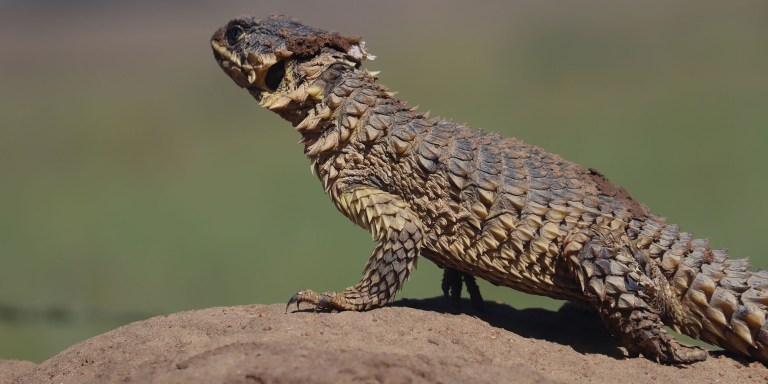
Sungazer lizards are endemic to South Africa and therefore found nowhere else in the world and are listed globally as ‘vulnerable’ on the IUCN Red List of Threatened Species. (Photo: Bradley Gibbons | EWT)
By Julia Evans | 25 Jul 2023
A yearslong investigation by the Green Scorpions paid off on Monday when two South Africans were sentenced for smuggling vulnerable sungazer lizards.
___________________________________________________________________________________________________________________________
Husband and wife Gerald and Elisha van der Westhuizen were on Monday convicted and sentenced at the Kempton Park Magistrates’ Court for the unlawful export of vulnerable sungazer lizards and money laundering.
“It is essential to recognise that biodiversity crimes, unlike other forms of crime, are a time-critical issue. Our natural resources are finite and may have permanent consequences,” read the plea and sentencing agreement between the prosecutor and the accused.
Sungazers, a species endemic to South Africa, are listed as vulnerable on the International Union for Conservation of Nature Red List of Threatened Species and locally in the 2014 Atlas and Red List of the Reptiles of South Africa, Lesotho and Swaziland.
The couple was sentenced after pleading guilty to five counts related to exporting species listed in the Convention on International Trade of Endangered Species (CITES) without a permit and four counts related to money laundering and the use of the proceeds from unlawful action.
The exporting of sungazer lizards contravenes the National Environmental Management: Biodiversity Act (Nemba).
Gerald van der Westhuizen, who was charged with exporting the vulnerable species, was sentenced to pay a fine of R1-million, half of which was suspended for five years on condition that he is not convicted of contravening Nemba in the next five years.
Elisha van der Westhuizen, who was charged with laundering the payment the couple received for the species, was sentenced to five years of direct imprisonment, suspended for five years on condition that she does not contravene Nemba within that period.
How the investigation went down
On 24 May 2019, SA Revenue Service customs officials were conducting a routine inspection at OR Tambo International Mail Centre when they found a parcel on its way to Germany containing six sungazer lizards, two of which were dead.
The package was declared as a “gift teddy and candies”, with the lizards hidden inside the stuffed toy.
More than two years later, on 19 November 2021, two German nationals, Daniël Löhde and Marko Drescher, were arrested in Northern Cape and convicted for the illegal possession of and attempt to export listed reptiles.
At the time, the Department of Forestry, Fisheries and the Environment (DFFE) said in a statement that the arrests were the result of a “multi-agency reptile undercover operation”.
It said, “The collaboration by all members of the multidisciplinary team is to be commended. Without the dedication of the Green Scorpions, members of the security establishment, provincial officials and the private sector, we will not be able to win the war against wildlife crime.”
During the arrest, the German nationals’ phones were legally seized, which is how the Green Scorpions investigators were able to link the Van der Westhuizens to the crime. They found WhatsApp conversations, voice notes and photos between Lohde and Gerald van der Westhuizen about exporting sungazer lizards.
Guilty pleas
The accused, represented by attorney Crystal Keevy, entered into a plea agreement with the prosecutor, Pieter Erasmus.
Gerald van der Westhuizen pleaded guilty to unlawfully and intentionally exporting the six lizards that were found at OR Tambo on 24 May 2019, and to exporting species listed in Cites to Germany between 16 April and 7 May 2019 (before the OR Tambo incident), and to exporting the species to Mexico between 21 June and 6 August 2021 — totalling 18 sungazer lizards and three (attempted) exports requested by Lohde.
Elisha was charged with money laundering and possession or use of proceeds of unlawful activities after she received three payments from Löhde into her PayPal accounts, totalling R90,928 for 18 lizards in 2019.
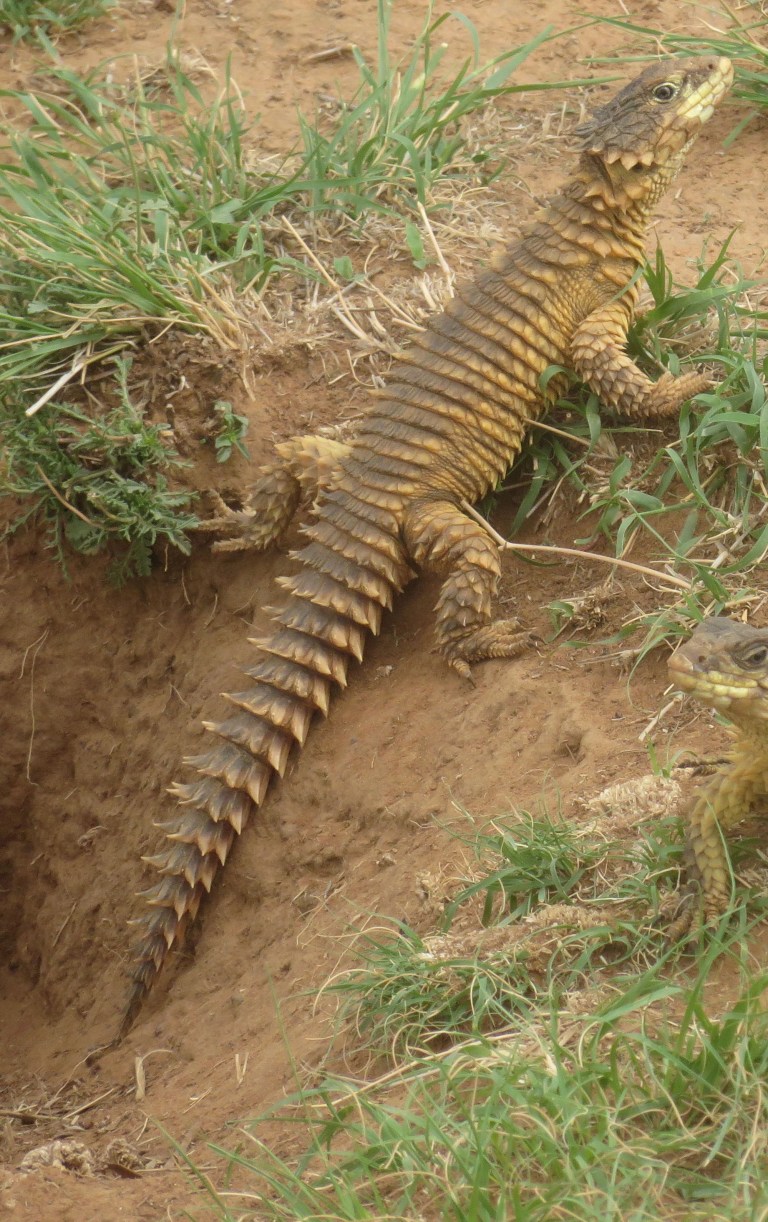
Sungazers are listed as a vulnerable species. (Photo: Bradley Gibbons / EWT)
A vulnerable species
Bradley Gibbons, a senior field officer at the Endangered Wildlife Trust, explained that sungazers “are found in a unique grassland type, making them habitat specialists, and [they] do not translocate easily, with many individuals not surviving during this process”.
Sungazers are listed as a vulnerable species, which means they face a high risk of extinction in the wild in the medium-term future.
“They are popular for the pet trade due to their characteristic posture and being calm,” Gibbons explained.
“Besides the use of Sungazers as live pets, the use of dead individuals is for traditional purposes when individuals are taken from the wild for use in muti [traditional medicine] as well as various forms of beliefs based on superstition to offer protection.” DM

Sungazer lizards are endemic to South Africa and therefore found nowhere else in the world and are listed globally as ‘vulnerable’ on the IUCN Red List of Threatened Species. (Photo: Bradley Gibbons | EWT)
By Julia Evans | 25 Jul 2023
A yearslong investigation by the Green Scorpions paid off on Monday when two South Africans were sentenced for smuggling vulnerable sungazer lizards.
___________________________________________________________________________________________________________________________
Husband and wife Gerald and Elisha van der Westhuizen were on Monday convicted and sentenced at the Kempton Park Magistrates’ Court for the unlawful export of vulnerable sungazer lizards and money laundering.
“It is essential to recognise that biodiversity crimes, unlike other forms of crime, are a time-critical issue. Our natural resources are finite and may have permanent consequences,” read the plea and sentencing agreement between the prosecutor and the accused.
Sungazers, a species endemic to South Africa, are listed as vulnerable on the International Union for Conservation of Nature Red List of Threatened Species and locally in the 2014 Atlas and Red List of the Reptiles of South Africa, Lesotho and Swaziland.
The couple was sentenced after pleading guilty to five counts related to exporting species listed in the Convention on International Trade of Endangered Species (CITES) without a permit and four counts related to money laundering and the use of the proceeds from unlawful action.
The exporting of sungazer lizards contravenes the National Environmental Management: Biodiversity Act (Nemba).
Gerald van der Westhuizen, who was charged with exporting the vulnerable species, was sentenced to pay a fine of R1-million, half of which was suspended for five years on condition that he is not convicted of contravening Nemba in the next five years.
Elisha van der Westhuizen, who was charged with laundering the payment the couple received for the species, was sentenced to five years of direct imprisonment, suspended for five years on condition that she does not contravene Nemba within that period.
How the investigation went down
On 24 May 2019, SA Revenue Service customs officials were conducting a routine inspection at OR Tambo International Mail Centre when they found a parcel on its way to Germany containing six sungazer lizards, two of which were dead.
The package was declared as a “gift teddy and candies”, with the lizards hidden inside the stuffed toy.
More than two years later, on 19 November 2021, two German nationals, Daniël Löhde and Marko Drescher, were arrested in Northern Cape and convicted for the illegal possession of and attempt to export listed reptiles.
At the time, the Department of Forestry, Fisheries and the Environment (DFFE) said in a statement that the arrests were the result of a “multi-agency reptile undercover operation”.
It said, “The collaboration by all members of the multidisciplinary team is to be commended. Without the dedication of the Green Scorpions, members of the security establishment, provincial officials and the private sector, we will not be able to win the war against wildlife crime.”
During the arrest, the German nationals’ phones were legally seized, which is how the Green Scorpions investigators were able to link the Van der Westhuizens to the crime. They found WhatsApp conversations, voice notes and photos between Lohde and Gerald van der Westhuizen about exporting sungazer lizards.
Guilty pleas
The accused, represented by attorney Crystal Keevy, entered into a plea agreement with the prosecutor, Pieter Erasmus.
Gerald van der Westhuizen pleaded guilty to unlawfully and intentionally exporting the six lizards that were found at OR Tambo on 24 May 2019, and to exporting species listed in Cites to Germany between 16 April and 7 May 2019 (before the OR Tambo incident), and to exporting the species to Mexico between 21 June and 6 August 2021 — totalling 18 sungazer lizards and three (attempted) exports requested by Lohde.
Elisha was charged with money laundering and possession or use of proceeds of unlawful activities after she received three payments from Löhde into her PayPal accounts, totalling R90,928 for 18 lizards in 2019.

Sungazers are listed as a vulnerable species. (Photo: Bradley Gibbons / EWT)
A vulnerable species
Bradley Gibbons, a senior field officer at the Endangered Wildlife Trust, explained that sungazers “are found in a unique grassland type, making them habitat specialists, and [they] do not translocate easily, with many individuals not surviving during this process”.
Sungazers are listed as a vulnerable species, which means they face a high risk of extinction in the wild in the medium-term future.
“They are popular for the pet trade due to their characteristic posture and being calm,” Gibbons explained.
“Besides the use of Sungazers as live pets, the use of dead individuals is for traditional purposes when individuals are taken from the wild for use in muti [traditional medicine] as well as various forms of beliefs based on superstition to offer protection.” DM
"Education is the most powerful weapon which you can use to change the world." Nelson Mandela
The desire for equality must never exceed the demands of knowledge
The desire for equality must never exceed the demands of knowledge
- Richprins
- Committee Member
- Posts: 76089
- Joined: Sat May 19, 2012 3:52 pm
- Location: NELSPRUIT
- Contact:
Re: WILDLIFE CRIME/TRADE/BREEDING
Please check Needs Attention pre-booking: https://africawild-forum.com/viewtopic.php?f=322&t=596
- Lisbeth
- Site Admin
- Posts: 67563
- Joined: Sat May 19, 2012 12:31 pm
- Country: Switzerland
- Location: Lugano
- Contact:
Re: WILDLIFE CRIME/TRADE/BREEDING

If the article gets online, I'll post it here
"Education is the most powerful weapon which you can use to change the world." Nelson Mandela
The desire for equality must never exceed the demands of knowledge
The desire for equality must never exceed the demands of knowledge


